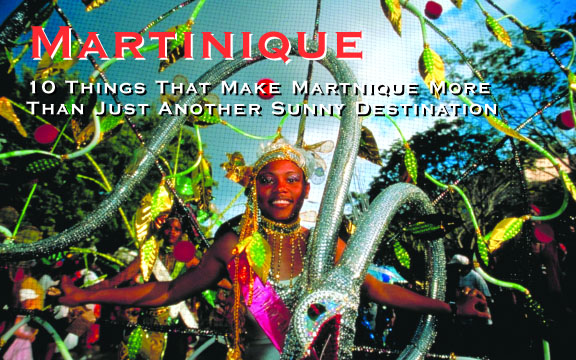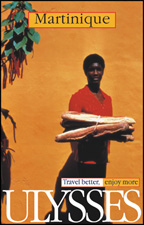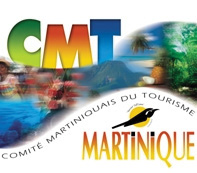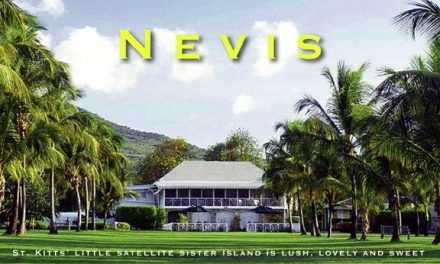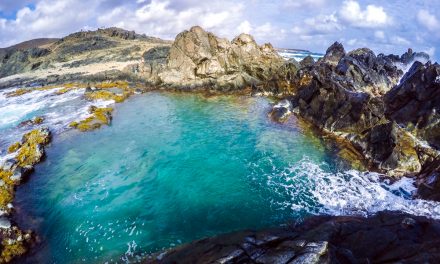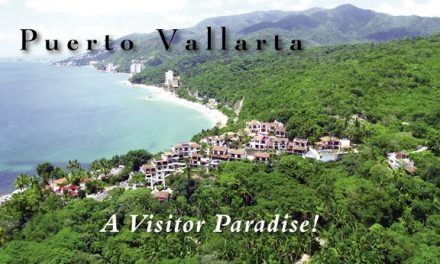Martinique
10 Things That Make Martinique More Than Just Another Sunny Destination
By Claude Morneau
Published in the January-February 2005 Issue of Canadian World Traveller
Text: Excerpt from Ulysses Martinique Travel Guide (www.ulyssesguides.com)
Photos: David Sanger (www.davidsanger.com)
Tourism Bureau: The Martinique Tourism Authority (www.martinique.org)
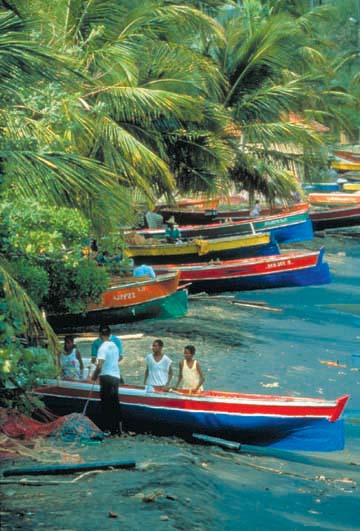 The island we now call Martinique was once known under other evocative names. According to legend, it was once called Matinino, or the “Island of Women”. The Carib Indians referred to is as Madinina or the “Island of Flowers”.
The island we now call Martinique was once known under other evocative names. According to legend, it was once called Matinino, or the “Island of Women”. The Carib Indians referred to is as Madinina or the “Island of Flowers”.
You’ll understand the inspiration as soon as you set foot on this tropical volcanic island. All at once, you’ll discover a little bit of France lost in the Antilles, a colourful Creole land, the home of Aimé Césaire and Patrick Chamoiseau, the birthplace of Empress Josephine, and a source of inspiration for Paul Gauguin.
Indeed, this island, bathed in sunlight, steeped in music, lined with superb beaches and abounding with a luxuriant plant life, will inspire anyone who takes time out to discover it.
The sun, the sea, the food, the turbulent history, the poetry, the people… Everything about Martinique makes it a beautiful, fascinating place to visit. Here are 10 things that make Martinique unique.
1. Great Hiking
This is probably the most well-organized outdoor activity on the island, as well as the one the island is trying hardest to develop. It is certainly the best means of introducing visitors to some of Martinique’s natural treasures, such as its tropical rainforest, the untouched beaches of its southeast coast, the rocky hills (mornes) and sharp peaks (pitons) that stud the island and, of course, Montagne Pelée.
The Office National des Forêts, the government agency dedicated to managing Martinique’s 15,000ha of woodland, has developed a network of 31 hiking trails (170 km), which it marks and maintains. The starting point for each of these trails is usually well indicated, with a map showing the path to follow.
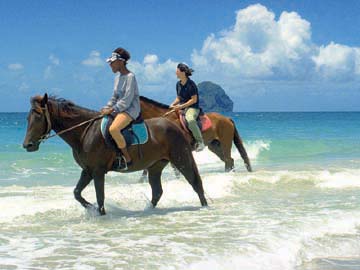 2. Non-Commercial Beaches and Fonds Blancs
2. Non-Commercial Beaches and Fonds Blancs
The many beaches that stretch along its coast and nestle inside its little bays (anses) constitute one of Martinique’s greatest natural assets.
There are the well-known white sandy beaches of the southern Caribbean coast (Grande Anse des Salines, Sainte-Anne, Diamant, Anse Mitan), lapped by the turquoise sea and lined with coconut trees.
But there are also the black-sand beaches of the northern Caribbean coast (Le Carbet, Anse Céron, Anse Couleuvre), with their own particularly mysterious atmosphere. Some visitors will enjoy roaming the pristine, isolated beaches of the southeast coast (Cap Chevalier, Anse Trabaud), where the choppy Atlantic is almost violent in places; others will prefer swimming farther north (Le François, Le Robert) among the fonds blancs, the shallow, white sandbars that are protected by coral reefs, and where the water is barely a metre deep.
3. Route de la Trace and Montagne Pelée
Route de la Trace is an essential part of any trip to Martinique; you can’t claim to know the island if you haven’t taken the famous Route de la Trace through the spectacular, luxuriant vegetation of the tropical rainforest, where the only sounds to break the silence are the singing of the birds, the gentle splashing of the waterfalls and the babbling of the streams. Farther away, Montagne Pelée, a volcano which is at least 400,000 years old, stands at 1,397m (4,656 ft). The most direct route up Montagne Pelée is by way of the Aileron trail, accessible from the village of Morne Rouge. This is a very popular trail, though a fairly challenging one.
4. Saint-Pierre, City of Art and History
Saint-Pierre is Martinique’s “martyred city”. Most of its population (30,000 people) perished when Montagne Pelée erupted on May 8th, 1902. Before this terrible catastrophe, Saint-Pierre and its theatres, beautiful buildings and magnificent residences was known as the “petit Paris des Antilles” (the little Paris of the Antilles), and its bourgeoisie lived a life of luxury. Today, the village is home to barely 5,000 people, who live on fishing, tourism, agriculture and livestock breeding. In 1990, Saint-Pierre was recognized as a part of the French national heritage, and dubbed the 101st “City of Art and History”.
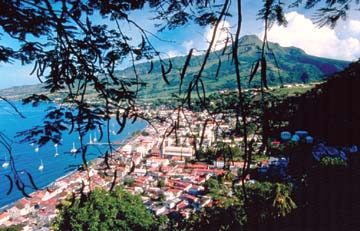 As far as tourism is concerned, Saint-Pierre, the true historical capital of Martinique, is of undeniable interest. A visit to the Musée Vulcanologique and the discovery of the countless ruins of significant monuments and the shipwrecks of the vessels that were moored in the harbour at the time of the tragic eruption are just a few examples of the rich cultural heritage that the residents of Saint-Pierre wish to commemorate.
As far as tourism is concerned, Saint-Pierre, the true historical capital of Martinique, is of undeniable interest. A visit to the Musée Vulcanologique and the discovery of the countless ruins of significant monuments and the shipwrecks of the vessels that were moored in the harbour at the time of the tragic eruption are just a few examples of the rich cultural heritage that the residents of Saint-Pierre wish to commemorate.
And if you’re interested in an easy and unusual way to discover Saint-Pierre’s many sights, climb aboard the Cyparis Express, a small train that will take you on a 1hr guided tour of the city.
5. Fabulous Creole Cuisine
Martinique is teeming with great places to eat, so you can enjoy excellent food all over the island. Indeed, this is without question one of the best things about this sunny travel spot. Your stay in Martinique will give you a chance to discover Creole cuisine, which is both varied and delicious.
Several good restaurants on the island still serve traditional Creole cuisine, a mixture of African, Indian, French and Caribbean influences, while a few others have ventured into the realm of nouvelle cuisine Créole, which draws its inspiration from the latest French trends while continuing to make use of local ingredients.
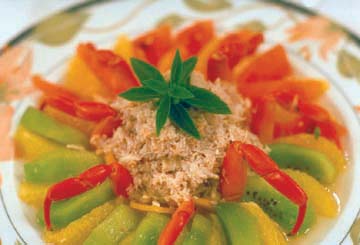 6. The Best Rum in the Antilles
6. The Best Rum in the Antilles
The number one alcohol produced in Martinique is of course rum, which the islanders rightly claim is the best in the Antilles.
Closely linked to the island’s history, the rum industry is steeped in tradition and plays an integral role in West Indian culture. Furthermore, Martinican agricultural rum was awarded the Appellation d’Origine Contrôlée (A.O.C.) label in the fall of 1996, a first for a French overseas product.
There are many rum distilleries spread all over the island, most of which offer guided tours of their facilities and arrange tasting sessions. Some distilleries even include “mini-museums” detailing the intricacies of their art (such as Plantations Saint-James).
7. The Island of Flowers
Another of Martinique’s great assets is its rich and varied flora, which should come as no surprise to those familiar with the island’s Carib name, Madinina (“Island of Flowers”). The unruly luxuriance of the tropical rain forest in the north and the thousands of multicoloured flowers (anthurium, hibiscus, poinsettia, bougainvillea, allemandes, red lavender) found all over the island are the obvious cornerstones of Martinique’s reputation.
8. Music and Dance
From wild rhythms to romantic melodies, music breathes energy into every event in Martinique. It is an integral part of Martinican life and has taken on many different forms over the years, reflecting the island’s cultural melting pot. Of all the types of dance music found in the Antilles, one has made a name for itself around the world since the 1980s: zouk. Lively and even boisterous, this distinctly modern form of musical expression nevertheless has firm roots in Antillean history and tradition.
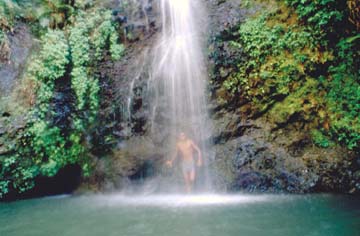 9. The Annual Carnival
9. The Annual Carnival
Several competitions, including a beauty contest, take place in Martinique during the month and a half that leads up to Carnival. The long-awaited festivities begin on the Sunday before Ash Wednesday and liven up the streets for four days.
Carnival starts with a parade of floats, then a wave of musicians, peddlers, dancers, and of course residents floods into the streets, and then things really get going. The festivities come to an end on Ash Wednesday with the burning of Vaval, an effigy of Carnival.
10. The Numerous Villas and Gîtes Ruraux
Renting a villa that can accommodate two to ten people has become an increasingly popular option in Martinique. The Comité Martiniquais du Tourisme can assist you in finding what you need among the hundreds of villas that are available to visitors. There are also over 350 gîtes ruraux (rental houses) and chambres d’hôte (bed and breakfast establishments) in Martinique. These types of accommodations enable visitors to get to know some of the people who live in the island’s rural areas and discover their way of life. A great alternative to traditional hotels!
Claude Morneau is the author of the Ulysses’ travel guide to Martinique (see cover on left), available in all good bookstores or on the Web at www.ulyssesguides.com.
For More Info:
The Martinique Tourism Authority
Tel: 1-866-313-7262
www.martinique.org

